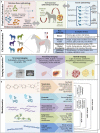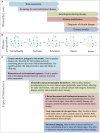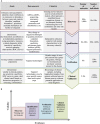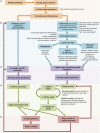The Scope of Big Data in One Medicine: Unprecedented Opportunities and Challenges
- PMID: 29201868
- PMCID: PMC5696324
- DOI: 10.3389/fvets.2017.00194
The Scope of Big Data in One Medicine: Unprecedented Opportunities and Challenges
Abstract
Advances in high-throughput molecular biology and electronic health records (EHR), coupled with increasing computer capabilities have resulted in an increased interest in the use of big data in health care. Big data require collection and analysis of data at an unprecedented scale and represents a paradigm shift in health care, offering (1) the capacity to generate new knowledge more quickly than traditional scientific approaches; (2) unbiased collection and analysis of data; and (3) a holistic understanding of biology and pathophysiology. Big data promises more personalized and precision medicine for patients with improved accuracy and earlier diagnosis, and therapy tailored to an individual's unique combination of genes, environmental risk, and precise disease phenotype. This promise comes from data collected from numerous sources, ranging from molecules to cells, to tissues, to individuals and populations-and the integration of these data into networks that improve understanding of heath and disease. Big data-driven science should play a role in propelling comparative medicine and "one medicine" (i.e., the shared physiology, pathophysiology, and disease risk factors across species) forward. Merging of data from EHR across institutions will give access to patient data on a scale previously unimaginable, allowing for precise phenotype definition and objective evaluation of risk factors and response to therapy. High-throughput molecular data will give insight into previously unexplored molecular pathophysiology and disease etiology. Investigation and integration of big data from a variety of sources will result in stronger parallels drawn at the molecular level between human and animal disease, allow for predictive modeling of infectious disease and identification of key areas of intervention, and facilitate step-changes in our understanding of disease that can make a substantial impact on animal and human health. However, the use of big data comes with significant challenges. Here we explore the scope of "big data," including its opportunities, its limitations, and what is needed capitalize on big data in one medicine.
Keywords: bioinformatics; clinical informatics; deep phenotyping; environmental epidemiology; genetic epidemiology; multilayer disease module; network medicine; structural informatics.
Figures







Similar articles
-
Translation in Data Mining to Advance Personalized Medicine for Health Equity.Intell Inf Manag. 2016 Jan;8(1):9-16. doi: 10.4236/iim.2016.81002. Intell Inf Manag. 2016. PMID: 27195185 Free PMC article.
-
-Omic and Electronic Health Record Big Data Analytics for Precision Medicine.IEEE Trans Biomed Eng. 2017 Feb;64(2):263-273. doi: 10.1109/TBME.2016.2573285. Epub 2016 Oct 10. IEEE Trans Biomed Eng. 2017. PMID: 27740470 Free PMC article. Review.
-
Integration of Omics and Phenotypic Data for Precision Medicine.Methods Mol Biol. 2022;2486:19-35. doi: 10.1007/978-1-0716-2265-0_2. Methods Mol Biol. 2022. PMID: 35437716 Review.
-
From Big Data to Precision Medicine.Front Med (Lausanne). 2019 Mar 1;6:34. doi: 10.3389/fmed.2019.00034. eCollection 2019. Front Med (Lausanne). 2019. PMID: 30881956 Free PMC article. Review.
-
From big data analysis to personalized medicine for all: challenges and opportunities.BMC Med Genomics. 2015 Jun 27;8:33. doi: 10.1186/s12920-015-0108-y. BMC Med Genomics. 2015. PMID: 26112054 Free PMC article. Review.
Cited by
-
Computer clinical decision support that automates personalized clinical care: a challenging but needed healthcare delivery strategy.J Am Med Inform Assoc. 2022 Dec 13;30(1):178-194. doi: 10.1093/jamia/ocac143. J Am Med Inform Assoc. 2022. PMID: 36125018 Free PMC article.
-
Individual differences in the encoding of contextual details following acute stress: An explorative study.Eur J Neurosci. 2022 May;55(9-10):2714-2738. doi: 10.1111/ejn.15067. Epub 2020 Dec 15. Eur J Neurosci. 2022. PMID: 33249674 Free PMC article.
-
Initiatives, Concepts, and Implementation Practices of FAIR (Findable, Accessible, Interoperable, and Reusable) Data Principles in Health Data Stewardship Practice: Protocol for a Scoping Review.JMIR Res Protoc. 2021 Feb 2;10(2):e22505. doi: 10.2196/22505. JMIR Res Protoc. 2021. PMID: 33528373 Free PMC article.
-
Early Detection of Bacteraemia Using Ten Clinical Variables with an Artificial Neural Network Approach.J Clin Med. 2019 Oct 2;8(10):1592. doi: 10.3390/jcm8101592. J Clin Med. 2019. PMID: 31581716 Free PMC article.
-
Identifying correlations driven by influential observations in large datasets.Brief Bioinform. 2022 Jan 17;23(1):bbab482. doi: 10.1093/bib/bbab482. Brief Bioinform. 2022. PMID: 34864851 Free PMC article.
References
-
- Sagiroglu S, Sinanc D. Big data: a review. 2013 International Conference on Collaboration Technologies and Systems (CTS) San Diego, CA: IEEE (2013). p. 42–7.
Publication types
LinkOut - more resources
Full Text Sources
Other Literature Sources

